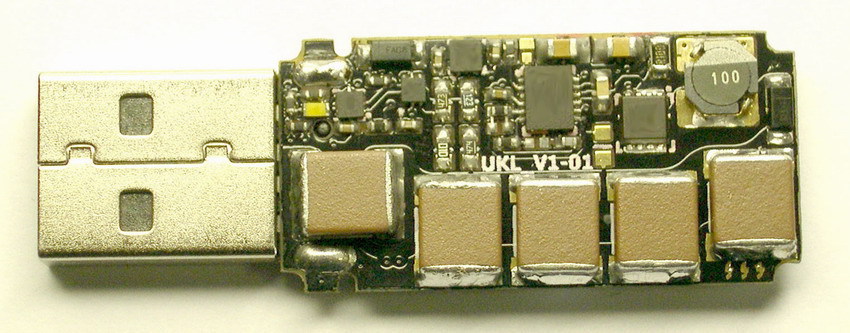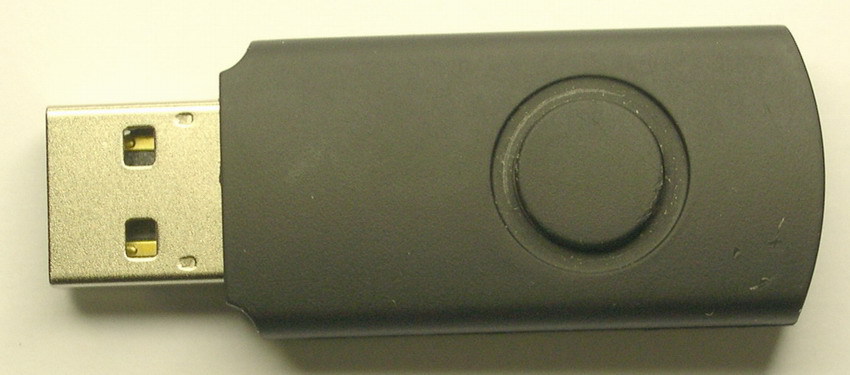Usb killer
It was the usual gloomy winter morning, my colleagues and I, as usual, drank morning coffee, shared the news, nothing foretold misfortune. But here the friend told ... further quote from Skype chat:
Picture to attract attention:

')
Since I work at an enterprise that develops and manufactures electronics, my colleagues and I began to actively discuss options for implementing such a flash drive, which would “burn the polkomp.” There were a lot of hardcore, fantastic, and also very real options. And everything would have ended with this cheerful discussion, if I had not intended to order the manufacture of printed circuit boards for my other projects.
So, the USB interface of the computer, as a rule, incorporates USB connector-> ESD diodes (static protection) -> filter elements -> protective elements in the chip itself, which contains the physical layer of the USB interface. In modern computers, USB “physics” is embedded almost in the processor itself, in computers a little bit older for USB, northeast bridges are responsible. The task of the developed flash drive is toburn the whole thing, at least kill the USB port.
Within a week, I developed a very specific circuit design, ordered the components, and after a few months of waiting for the components, a fully functional prototype was assembled. The idea itself was tested and everything that was possible was “burned”.

Next, printed circuit boards were developed and ordered in China, and a combat sample was mounted.
It is soldered manually by me, the installer from me is so-so.


It was made under the body from the usual flash drive.

The principle of operation of the flash drive is quite simple. When connected to the USB port, an inverting DC / DC converter is launched and charges the capacitors to -110V, when this voltage is reached, the DC / DC turns off and at the same time the field-effect transistor opens, through which -110V is applied to the USB interface signal lines. Further, when the voltage on the capacitors drops to -7V, the transistor closes and DC / DC is started. And so in the cycle until everything and everything breaks through. The inquisitive mind of a reader familiar with electronics has already figured out why negative voltage is used, for others I will explain that switching voltage is simpler, since an N-channel field effect transistor is needed, which, unlike a P-channel, can have a much larger current with the same dimensions.
I will not speak about the scope, but a former colleague says that it is like an atomic bomb, it's cool to have, you just can't use it.
I once read an article as a guy in the subway pulled a flea bag from a mesh pocket from the mesh pocket, on which 128 was written. I came home, put it in a laptop -> I burned a computer floor ... I wrote 129 on a flash drive and now wears it in the outer pocket of my bag ...
Picture to attract attention:

')
Since I work at an enterprise that develops and manufactures electronics, my colleagues and I began to actively discuss options for implementing such a flash drive, which would “burn the polkomp.” There were a lot of hardcore, fantastic, and also very real options. And everything would have ended with this cheerful discussion, if I had not intended to order the manufacture of printed circuit boards for my other projects.
So, the USB interface of the computer, as a rule, incorporates USB connector-> ESD diodes (static protection) -> filter elements -> protective elements in the chip itself, which contains the physical layer of the USB interface. In modern computers, USB “physics” is embedded almost in the processor itself, in computers a little bit older for USB, northeast bridges are responsible. The task of the developed flash drive is to
Within a week, I developed a very specific circuit design, ordered the components, and after a few months of waiting for the components, a fully functional prototype was assembled. The idea itself was tested and everything that was possible was “burned”.

Next, printed circuit boards were developed and ordered in China, and a combat sample was mounted.
Oftop.
Plyty ordered here . Terribly dissatisfied with quality, copper seems to be nothing, but the mask falls off, silk screen printing is generally horror. Consider anti-advertising.
It is soldered manually by me, the installer from me is so-so.


It was made under the body from the usual flash drive.

The principle of operation of the flash drive is quite simple. When connected to the USB port, an inverting DC / DC converter is launched and charges the capacitors to -110V, when this voltage is reached, the DC / DC turns off and at the same time the field-effect transistor opens, through which -110V is applied to the USB interface signal lines. Further, when the voltage on the capacitors drops to -7V, the transistor closes and DC / DC is started. And so in the cycle until everything and everything breaks through. The inquisitive mind of a reader familiar with electronics has already figured out why negative voltage is used, for others I will explain that switching voltage is simpler, since an N-channel field effect transistor is needed, which, unlike a P-channel, can have a much larger current with the same dimensions.
I will not speak about the scope, but a former colleague says that it is like an atomic bomb, it's cool to have, you just can't use it.
UPD_18mar2015:
In connection with the appearance on the Internet of many copies of my article, as well as translations into other languages, allegedly with my authorship, I bring to the attention of readers that I have published an article only on the website habrahabr.ru and nowhere else.
For any questions write here: darkzpurple@gmail.com
For any questions write here: darkzpurple@gmail.com
Source: https://habr.com/ru/post/251451/
All Articles